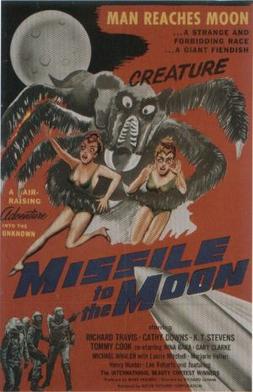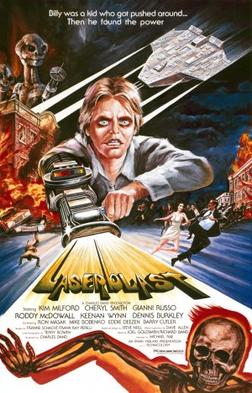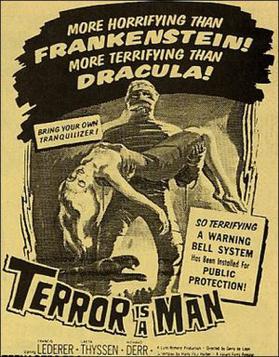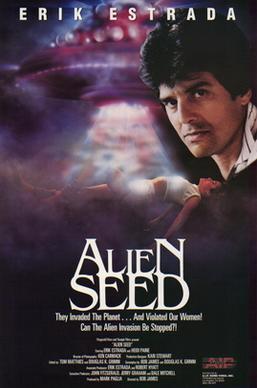Science fiction films This is a list of science fiction films organized chronologically. These films have been released to a cinema audience by the commercial film industry and are widely distributed with reviews by reputable critics. This includes silent film–era releases, serial films, and feature-length films. All of the films include core elements of science fiction, but can cross into other genres such as drama, mystery, action, horror, fantasy, and comedy.

Bishop, designated HS17B48XG5-D5, is a fictional character in the movie Aliens, who was portrayed by actor Lance Henriksen. The character is the science officer of the Sulaco, and his actions and self-sacrifice are critical to the survival of Ellen Ripley. When Ripley discovers that Bishop is an android, just like Ash, an antagonist of the first Alien film, she initially treats him with extreme distrust due to her previous experiences.

Missile to the Moon is a 1958 independently made American black-and-white science fiction film drama, produced by Marc Frederic, directed by Richard E. Cunha, that stars Richard Travis, Cathy Downs, and K. T. Stevens. The film was distributed by Astor Pictures and is a remake of an earlier Astor Pictures-distributed film, Cat-Women of the Moon (1953). Missile to the Moon was released in late 1958 as a double feature with Cunha's Frankenstein's Daughter.
Wilma Deering is a fictional character featured in the various iterations of Buck Rogers which have spanned many media over the years.

Laserblast is a 1978 American independent science fiction film directed by Michael Rae and produced by Charles Band, widely known for producing B movies. Starring Kim Milford, Cheryl Smith and Gianni Russo, featuring Keenan Wynn and Roddy McDowall, and marking the screen debut of Eddie Deezen, the plot follows an unhappy teenage loner who discovers an alien laser cannon and goes on a murderous rampage, seeking revenge against those who he feels have wronged him.

Alienator is a 1990 science fiction film directed by Fred Olen Ray, produced by Jeffrey C. Hogue, and starring Jan-Michael Vincent.

The Psychotronic Man is a 1979 American independent science fiction cult film directed, shot and edited by Jack M. Sell, and written, produced and starred Peter G. Spelson. The film opened in Chicago at the Carnegie Theatre on April 23, 1980.

Arena is a 1989 American science fiction action film directed by Peter Manoogian and starring Paul Satterfield and Claudia Christian. Set in 4038, Satterfield plays Steve Armstrong, the first human in 50 years to compete in the intergalactic boxing sport called simply "The Arena". The film was produced by Irwin Yablans and features original music by Richard Band.

The Midnight Hour is a 1985 American made-for-television comedy horror film directed by Jack Bender and starring Shari Belafonte-Harper, LeVar Burton, Peter DeLuise, and Dedee Pfeiffer. Its plot focuses on a small New England town that becomes overrun with zombies, witches, vampires, and all the other demons of hell after a group of teenagers unlocks a centuries-old curse on Halloween.

Xtro 3: Watch the Skies is a 1995 American science-fiction horror film directed by Harry Bromley Davenport and starring Sal Landi, Andrew Divoff, Karen Moncrieff, Jim Hanks, Virgil Frye and Robert Culp. It is the third installment in the series after Xtro and Xtro II: The Second Encounter, and is once again unconnected to the previous ones, other than through its alien intrusion themes. In it, an alien seeks revenge for experiments conducted by the American government on one of his fellow aliens forty years prior.

Psychotronic Video was an American film magazine founded by publisher/editor Michael J. Weldon in 1980 in New York City, covering what he dubbed "psychotronic movies", which he defined as "the ones traditionally ignored or ridiculed by mainstream critics at the time of their release: horror, exploitation, action, science fiction, and movies that used to play in drive-ins or inner city grindhouses." It was published through 2006. Most of the magazine's hundreds of reviews were written by Weldon himself. Other contributors provided career histories/interviews with cult filmmakers and actors such as Radley Metzger, Larry Cohen, Jack Hill, William Rotsler, David Carradine, Sid Haig, Karen Black, and Timothy Carey. Regular features included "Record Reviews" by Art Black, "Spare Parts" by Dale Ashmun, and "Never To Be Forgotten", an obituary column.

Terror Is a Man is a 1959 black-and-white Filipino/American horror film directed by Gerardo de Leon.
Nicholas "Nick" J. Corea was an American author, television writer, director, producer and painter. Though best known for his work on The Incredible Hulk and its sequel 1988 telefilm The Incredible Hulk Returns, he was involved with many television series during the late 1970s and 1980s including The Oregon Trail, Airwolf, Street Hawk, Hard Time on Planet Earth and Booker. He was also the creator of the 1986 western series Outlaws.

Future Force is a 1989 science-fiction film written and directed by David A. Prior and starring David Carradine. A 1990 sequel to the film was made called Future Zone.

Dead Men Don't Die is a 1990 American horror-comedy film written and directed by Malcolm Marmorstein and starring Elliott Gould and Melissa Sue Anderson.

Alien Seed is a 1989 American science fiction film written and directed by Bob James and starring Erik Estrada. It was released by action International
Sara Suzanne Brown is an American actress who is best known for her appearances in softcore erotic films between 1991 and 1995. She made her film debut in a small role as a background dancer in The Last Boy Scout (1991). Among her films include Secret Games 2: The Escort (1993), Mirror Images 2 (1993), Test Tube Teens from the Year 2000 (1993), and Killer Looks (1994).

Future Hunters is a 1986 action adventure film directed by Cirio H. Santiago and written by J. Lee Thompson. It stars Robert Patrick and Linda Carol with a cameo appearance of Richard Norton and Bruce Lee impersonator Bruce Le.














